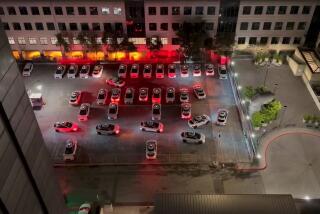Lights Don’t Cure All Ills of Intersection
- Share via
Dear Traffic Talk:
The traffic light that was recently installed on Winnetka Avenue at Mayall Street in Chatsworth has turned out to be a counterproductive disaster.
It now takes much longer for Mayall drivers to make left turns or go across Winnetka because the light is extremely long.
One could make the turn in 10 to 15 seconds at most prior to the installation of the light because the traffic on Winnetka is so light.
Drivers on Winnetka now are slowed up needlessly since there are few cars on Mayall most of the time.
How about declaring this light a menace to traffic, tear it up and chalk the $100,000-plus wasted on it as another bureaucratic bungle?
Carl Olson
Woodland Hills
Dear Carl:
Traffic lights are not intended to fix all the problems at a particular intersection and inevitably there are trade-offs, according to authorities.
Sometimes it is true that adding traffic signals causes more traffic problems than it solves, said Brian Gallagher of the Los Angeles Department of Transportation. Small residential intersections operate most efficiently with stop signs that allow drivers and pedestrians to proceed between natural gaps in traffic.
When a light is put up at a residential neighborhood’s main thoroughfares, however, area residents are guaranteed they will have access to the main street every minute or so. The trade-offs include an increased waiting time--often frustrating during off-peak hours--and increased traffic lured by the stoplight, Gallagher said.
Such lights are not intended to stop many lanes of traffic in each direction on major streets any time a vehicle needs to exit the residential neighborhood, Gallagher said.
At this particular intersection, there are vehicle sensors and pedestrian push-buttons for Mayall that prevent the signals for Winnetka from going to red unless there is demand.
Gallagher said the light is also coordinated with the nearby Winnetka-Devonshire intersection to minimize stops and delays for traffic on Winnetka.
*
Dear Traffic Talk:
I recently read in this column an answer regarding carpool lanes.
I have noticed that at times there is a single white line to the inside of the double-yellow lines, while at other times there is just a double-yellow.
Is it OK to move out of a carpool lane when that single white line appears?
Brian Wilkening
Glendale
Dear Brian:
It is not OK to exit the carpool lanes when the white line appears, according to authorities.
The California Vehicle Code states that no car is allowed to drive on the left side of double-yellow lines, such as those marking no-passing zones on two-way highways, said Pat Reid, a Caltrans spokeswoman.
The typical carpool lane buffer striping in L.A. County consists of a double-yellow line and a single white line--at the left of the double yellow. The white lines on freeways are meant to differentiate the carpool buffer zones from the no-passing zones on highways, Reid said.
Freeway motorists are allowed to drive on the left side of the white line.
Entering or exiting carpool lanes is only allowed at the broken white lines, Reid said.
*
Traffic Talk appears Fridays in The Times Valley Edition. Readers may submit comments and questions about traffic in the Valley to Traffic Talk, Los Angeles Times, 20000 Prairie St., Chatsworth 91311. Include your name, address and phone number. Letters may be edited, and no anonymous letters will be accepted. To record your comments, call (818) 772-3303. Fax letters to (818) 772-3385. E-mail questions to [email protected]
More to Read
Sign up for Essential California
The most important California stories and recommendations in your inbox every morning.
You may occasionally receive promotional content from the Los Angeles Times.










